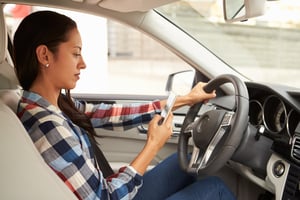 Almost every state nationwide has some kind of law on texting while driving. Drivers know texting in the car isn’t safe and can lead to fines or jail time if caught, but many have continued to do so. But they’re not fooling anyone as it’s easy to spot.
Almost every state nationwide has some kind of law on texting while driving. Drivers know texting in the car isn’t safe and can lead to fines or jail time if caught, but many have continued to do so. But they’re not fooling anyone as it’s easy to spot.
Police Bird’s-Eye View
Police driving in elevated SUVs and motorcycles have a bird’s-eye view of a driver’s hands.
- Even if the driver appears to be looking forward, a phone on the steering wheel or instrument panel is one of the easiest ways for police to catch texting drivers.
- The bright glow of a screen will light up an entire car when driving, particularly at night.
- If the police can’t see the driver’s hands, another indicator the driver is texting is the driver is continually looking down. Drivers try to do this to hide their phone (the opposite of the last example) but can be constantly distracted from keeping their eyes on the road.
Traffic and Highway Cameras
City cameras are frequently located at the busiest intersections in the city and at lanes getting off and on the highway. Typically, these cameras are used to see if people run red lights, other traffic violations, or, in extreme cases, identifying drivers for police investigations. However, they can be and are used to catch texting drivers as well.
Future Methods
These methods are subject to state regulations and future testing, and although not widely implemented today, they’re useful for proving texting while driving violations:
Texting Records.
In the case of an accident, police can consult cell phone records to see if texting might have led to the accident, thereby placing blame on the driver who was texting. In the future, some feel this could be implemented at everyday traffic stops instead of under extreme circumstances.
Text Analyzer.
A text analyzer prototype is much like a police radar for texting, except instead of measuring speed it analyzes frequencies from a driver’s cell phone to see if it is being used for texting. This type of access could be subject to state privacy laws and could be subject to a required warrant.
So, what CAN you do with your phone while driving?
Check your state statutes first. Typically, drivers depending on age, may use their device as long as it’s in hands-free mode or if there’s some sort of emergency requiring the driver to use the device. Here are some examples of actions that are normally acceptable:
In hands-free mode:
-
Make a phone call.
-
Initiate, send, or listen to an electronic message.
-
View or operate a GPS/navigation system that doesn’t require typing while the vehicle is in motion or in traffic.
-
Listen to audio-based content.
Not in hands-free mode:
-
Obtain emergency assistance.
-
React to life-or-death circumstances.
What happens if you get caught?
Punishment for texting and driving typically requires some sort of proof: eyewitness testimony, admission from the driver, evidence from the phone itself, public information/social media, or information obtained through an authorized search warrant. Whatever the method, it’s best to put the phone down while driving to avoid a costly fine or jail time.





